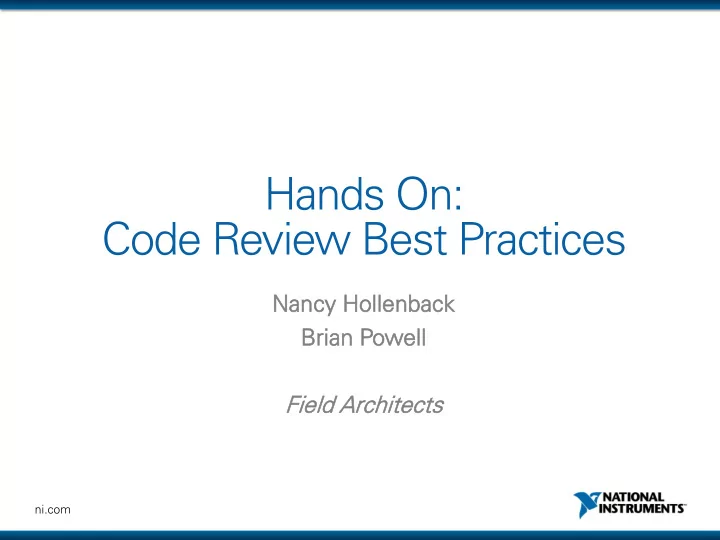

Hands On: Code Review Best Practices Nan ancy cy Hol ollenback lenback Bria Br ian n Powel ell Fi Field eld Ar Arch chitect itects ni.com
Agenda • A little background • Group review of a VI • Demo of some tools • Independent review of a couple of VIs • Discussion ni.com
What is a Code Review? Cod ode e re revie iew w — A systematic examination of source code with the intent of finding and fixing mistakes that were overlooked during development. • Take others on a tour of your code • “The best code reviews are the ones that actually get done. ” ni.com
Design vs. Code Reviews • Design reviews are done before much code is written • Code reviews are done after the code is “done” • At least the part you’re reviewing • Code reviews are sometimes called “implementation reviews” ni.com
LabVIEW and The Software Engineering Process Requirements Application Testing and Development Deployment Gathering Architecture Validation NI Design Graphical Diff LabVIEW Unit Application Requirements Patterns and Test Framework Builder Gateway Ref. Arch. SCC Real Object LabVIEW Time/FPGA Orientation Documentation VI Analyzer VIPM LabVIEW Architecture Coding Desktop Review Standards Execution Trace Now Inc nclud luded ed with th DevSu De Suite ite ni.com
Why even have a code review? • Improve quality • Force you to really look at your code • Educate others who might need to support your code • Share programming knowledge and techniques ni.com
Goals of Code Review • The items to examine during a code review include the following: • Correctness of implementation • Interaction with other components • Robustness and error handling • Conformance to group’s coding standards/practices • Readability • Completeness NI’s SEP Guidelines ni.com
The Code Review Process • Prepare! • Make sure the code works (meets requirements) • Make sure the code is worthy of review o Documented o Conforms to style guidelines o Etc. • Run the VI Analyzer (and fix issues) • Let others review in advance offline • Review • Raise issues, don’t resolve them • Capture action items • Don’t waste peoples’ time • Follow up • Address every action item • Consider a followup review ni.com
Review Team • Why have a team versus a single person? • Number of people? • Keep cost in mind: 2Hx5Dx5Px$100? = $5,000? • Types of people? • Vested interest – tech lead, back up people, future owners • Wide angle view • Narrow view ni.com
Some Dos and Don’ts • Do discuss the architecture and code • Don’t review the coder • Do discuss relevant, interesting, difficult code • Don’t discuss simple, common code • Do make notes of things to check into • Don’t check into them during the review • Do make notes of code to fix • Don’t edit code during the review ni.com
Capturing Issues • Issue tracking spreadsheet… http://labviewjournal.com ni.com
Let’s Review Some Code • Hewlett-Packard 8118A Pulse Generator Instrument Driver ni.com
Exercise 1: Review “Compression of a Metal Disc Problem.vi” • Help >> Find Examples • C:\Program Files (x86) \National Instruments\LabVIEW 2012 \examples\math\mechanix.llb\ Compression of a Metal Disk Problem.vi ni.com
Exercise 2: Review “Pulse and Transition Measurements.vi” • Help >> Find Examples • C:\Program Files (x86) \National Instruments\LabVIEW 2012 \examples\measure\maxmpl.llb \Pulse and Transition Measurements.vi ni.com
When Y ou Get Home… • Set up your style guidelines. • Define a code review process and START REVIEWING YOUR CODE! • Keep up with your skills • Stay current with your training. Consider intermediate and advanced courses. • Take advantage of NI and LAVA forums. • Attend user groups, CLD and CLA Summits. ni.com
Upcoming blog post, download slides and checklist at labviewjournal.com Thank you! ni.com
Recommend
More recommend